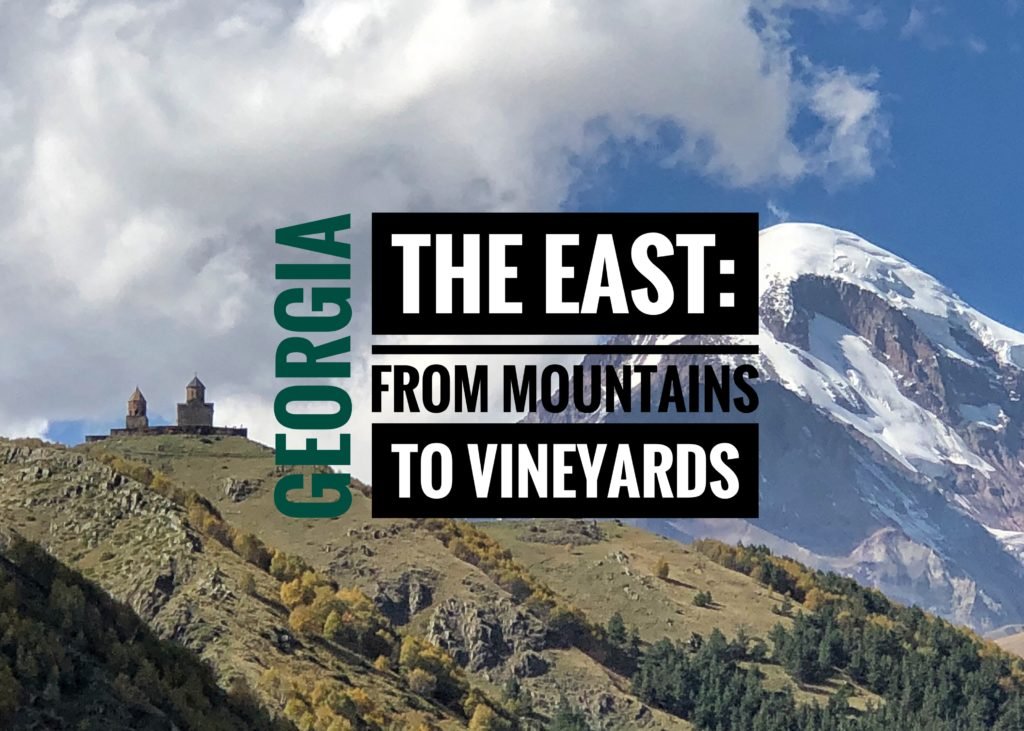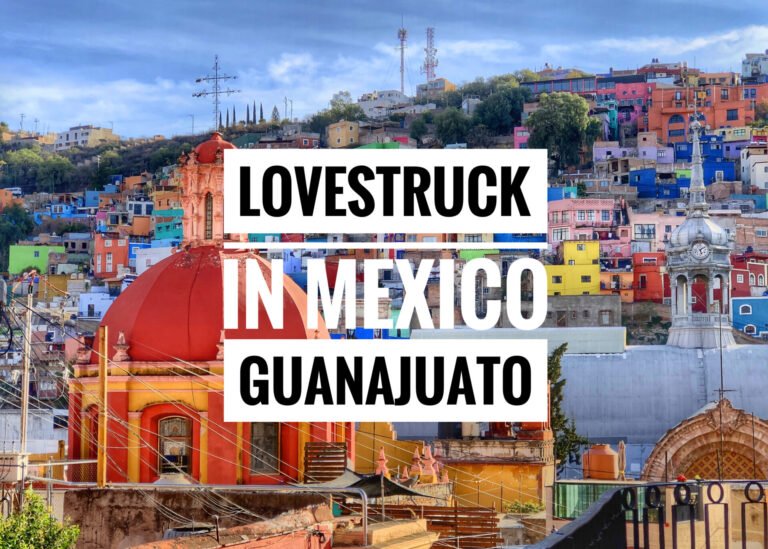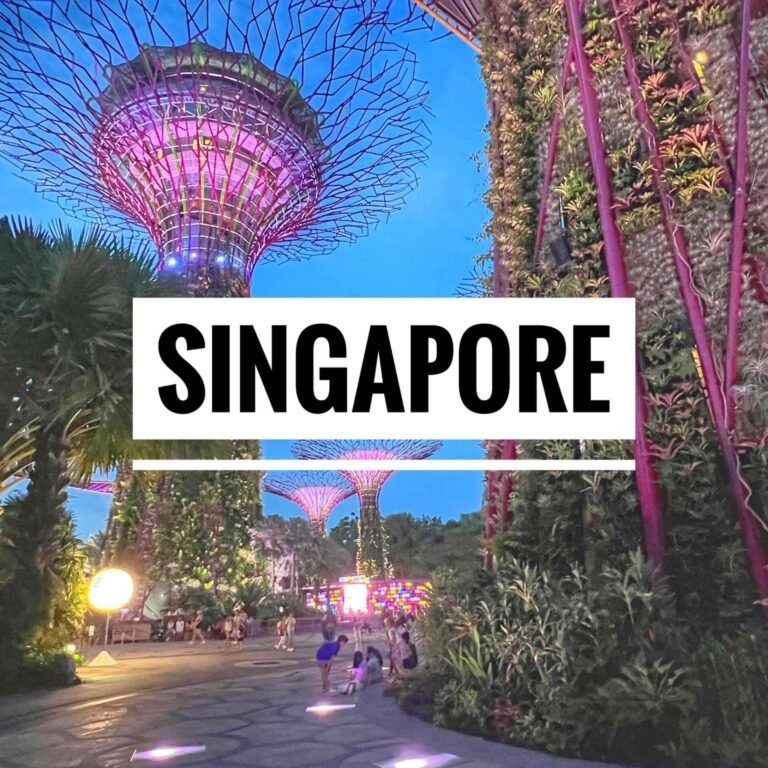
For our last two stops in Georgia, we longed to escape the cities and step into something a little more laid back and authentic. We chose Kazbegi, aka Stepantsminda, a deliciously Georgia-eous mountain townlet on the Russian border and Sighnaghi, a charming red-roofed village plopped in the middle of eastern Georgian wine country.
The ride to Stepantsminda (Kazbegi) was about three hours from Tbilisi and the marshrutka carnival ride continued as we whipped our way… to-and-fro, stop and go, that what makes the world go… oh, urm, climbing up serpentine roads into the mountians. But the view, once we got there was worth every nauseating and anxiety-inducing grip of the “oh-shit-handle” in the marshrutka. Also, why our destination town has two names… “Kazbegi” was the Soviet era name starting in 1925 after a local lord helped suppress a regional revolt against Soviet rule, and instead sided with Russia. Stepantsminda, named after St. Stephen was the town’s original name prior to soviet interference, and was it reverted to in 2006. Sounds a bit like Denali/McKinley….

The Ananuri Fortress, on the way to Stepantsminda, is set up over the reservoir. Inside are two 17th Century churches. The last battle here was in 1739 when it was set fire to and the last defenders were killed.

Another stop on the way into the Caucuses…an understandably popular paragliding destination.
Stepantsminda (Kazbegi)

Our $13/night view from our Airbnb room. Mt. Kazbek is a dormant volcano and one of the major mountains in the Caucus range at 16,512 feet. We thought it resembled Mt. Hood. Of course, Mt. Hood don’t have the view from the church like Kazbegi. Not even close.

We couldn’t help laughing at these fellow tourists and their poor luggage choice…The curse of the roller bag on cobblestone streets. Greg is really glad this is not Mandy…

Google…Market?! Who knew? They did not use the color green though so it’s conveniently a very different logo for them. We discovered this while walking around Kazbegi the first night after a power outage had turned off the lights in the restaurant we were eating at. Fortunately we got our food prior to this, but were unable to get our candy sweets at this store because their electric scales were out and they couldn’t weigh them.

The sunset on the first night.

Real Caucasian life… Street scene Stepantsminda. Incidentally, those pipes you see are the town natural gas lines… we couldn’t believe they elevate their gas lines in this way!

Waking up and looking out the window to this view was hypnotic…

…just couldn’t get enough.

Beginning the hike up to the Gergeti Trinity Church On the hill, we pass through the Gergeti village. Many beautiful stone structures are crumbling and neglected like this one.


The hike up to the church is a steep 1 1/2 hour climb, but well worth the effort. You can also cheat and take a mini-bus, but that would just be tragic on a day like this was.

The view from the church looking down in the valley at Stepantsminda.

The church is at an elevation of 7,120’ and was built in the 14th Century. In times of danger, precious relics from Mtskheta (Georgia’s holiest city) were brought here for safekeeping. During the Soviet era, all religious services were prohibited but the church is now active.

Obligatory selfie.

Mandy admires the view after the hike.

Views along the hike.



This lovely woman walked the rock laden 1 1/2 hour pilgrimage hike up to the church with bare feet! She kissed large rocks along the way and uttered a blessing, we also witnessed her walk around and kiss the outside of the church walls, and then the walls on the inside of the church. What true devotion… it was beautiful. It was kind of sad watching her make this journey and being surrounded by nothing but camera toting tourists, often wanting to take pictures with her, and the mini vans barreling up the hill… You know she just wanted peace.

After Stepantsminda, we took a much less crazy marshrutka back to Tbilisi and transferred to a different marshrutka bound for Sighnaghi and wine country. There is also lots of local shopping to be had in this town!
Sighnaghi

Sighnaghi is a picture-perfect postcard village, which seems like it belongs in Central Italy. It is set high on a bluff overlooking the Alazani Valley and the distant Caucus mountains. It is also 51 Kilometers from the Azerbaijan border and well known for being the wine capital of the Kahketi Region.

An absolutely amazing 4.5 kilometer intact town wall wraps all the way around the city, with at least 15 stone towers by our count, all from 18th century. The longest wall we have ever seen, it was truly impressive. Surprisingly, Sighnaghi was only founded in 1762 so it’s not “that old” relative to the other places we’ve been visiting in Georgia.

Bodbe Cathedral, was a 2 kilometer walk from Sighnaghi. It was originally built in 9th century and redone in the 17th Century. It is one of the most important pilgrimage sites in Georgia because the relics of St. Nino, a 4th Century female evangelist, are enshrined here. In 1924, the Soviet government closed down the church and turned it into a hospital. Notice a theme here? 🙁

More Soviet Lada cars! They are everywhere 🙂

Our cave-like dinner establishment was a 250 year old cellar. And the home-made phenomenal(!) wine (oh, it’s soooo good here!) was poured directly from this giant vessel into our table pitcher. Price, $4 for a liter.

More street scenes, Sighnaghi.

Lunch break with a view! This meal just $5.75!

Traditional Georgian balconies hug almost every building in Sighnaghi.

Ruins of yesterday overlooking the valley.

Nothing beats walking these streets with a glass of homemade wine sold by a local on the street in your hand. ($.80)

A beautiful church in Old Town.

Climbing the towers of the walls

Strolling through the lesser touristy part of the village, we walked by this lady who was out in her garden. When we said our usual greeting “gamarjoba” to her, she smiled and immediately followed with, “where are you from?” It was then we noticed a small sign by her fence that said, “Nino’s: Tea & History.” Excited to hear we were Americans, she immediately launched into her story in surprisingly well-spoken English. She had studied European Literature & History, as well as English, for many years in Tbilisi and recently moved back to Sighnaghi to take care of her aging father. Nino told us many facts about the history of Sighnaghi and invited us onto her ramshackled patio for tea, so she could show us her “museum,” which consisted of some 18th century wooden artifacts including wooden spoons, a spindle and a garlic press, which had been handed down for generations. She apologized profusely for the mess of dirty dishes all over her patio saying something about not having water. It was very evident that she was incredibly poverty-stricken. But her eyes were so kind and it was apparent she just wanted conversation. Her history “lessons” were well worth opening our pocketbook for and the appreciation on her face was heart wrenching. This is why we travel…





As we have many times in our Georgia adventure, for our last accommodation we stayed in a family guesthouse in Sighnaghi ($13/night). Although the view from our AirBnb guesthouse was fantastic, it was definitely a stitched together “shoebox” Of tight quarters, which reminded us yet again of the poverty that still surrounds. The walls were cobbled together and the floor boards old and weathered, so that 90 degree angles are a bit of an anomaly, the doors and windows never quite shut correctly, the doorknob was held together by cardboard, the floors never feel quite level, and the showers always spray all over the entire bathrooms because there’s no stall. (Watch your toilet paper! 🙂 Yes, while you can get a really nice room for just $10 more… staying more “like a local” here does remind us of how we have been very fortunate, and to stop and think how it’s easy to take for granted something simple like having 90 degree angles in your homes’ walls and floors. Despite their incredibly long and ancient history, the Georgians are certainly a resilient people…determined, and hands-down some of the most hospitable we’ve met…anywhere. We are grateful to have spent three weeks in this life-changing country.



